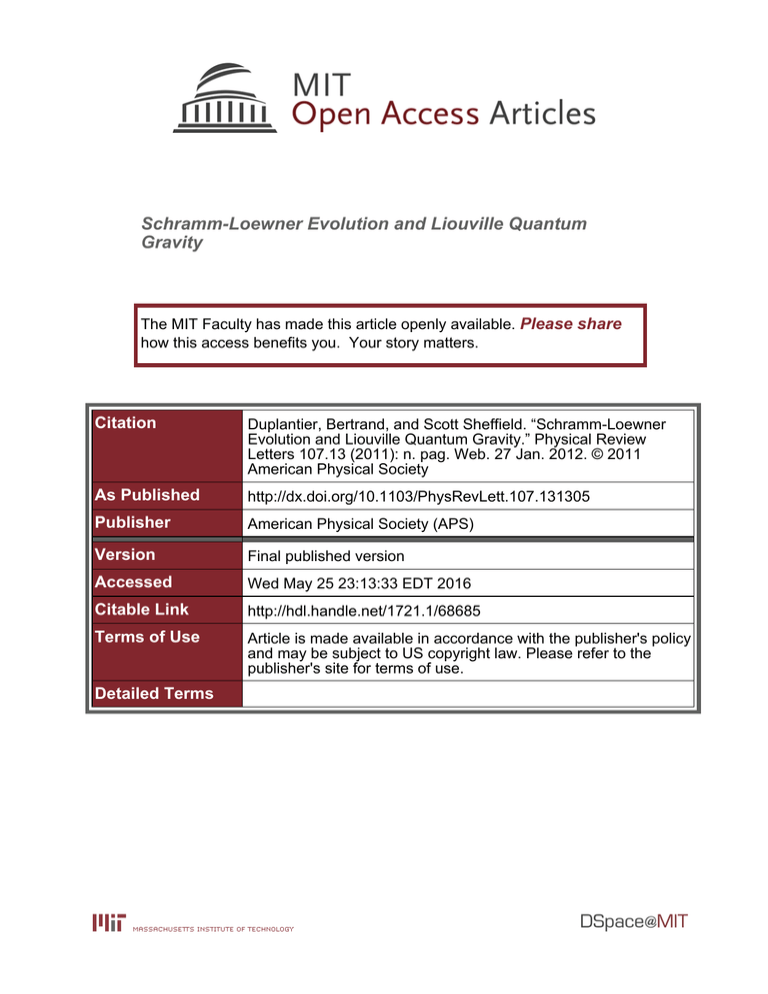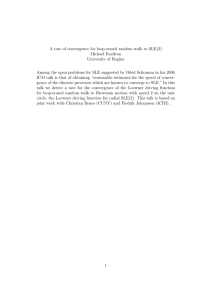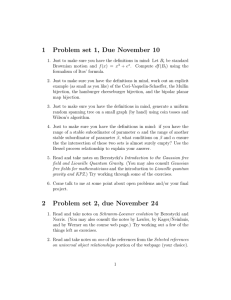Schramm-Loewner Evolution and Liouville Quantum Gravity Please share
advertisement

Schramm-Loewner Evolution and Liouville Quantum Gravity The MIT Faculty has made this article openly available. Please share how this access benefits you. Your story matters. Citation Duplantier, Bertrand, and Scott Sheffield. “Schramm-Loewner Evolution and Liouville Quantum Gravity.” Physical Review Letters 107.13 (2011): n. pag. Web. 27 Jan. 2012. © 2011 American Physical Society As Published http://dx.doi.org/10.1103/PhysRevLett.107.131305 Publisher American Physical Society (APS) Version Final published version Accessed Wed May 25 23:13:33 EDT 2016 Citable Link http://hdl.handle.net/1721.1/68685 Terms of Use Article is made available in accordance with the publisher's policy and may be subject to US copyright law. Please refer to the publisher's site for terms of use. Detailed Terms PRL 107, 131305 (2011) week ending 23 SEPTEMBER 2011 PHYSICAL REVIEW LETTERS Schramm-Loewner Evolution and Liouville Quantum Gravity Bertrand Duplantier1 and Scott Sheffield2 1 2 Institut de Physique Théorique, CEA/Saclay, F-91191 Gif-sur-Yvette Cedex, France Department of Mathematics, Massachusetts Institute of Technology, Cambridge, Massachusetts 02139, USA (Received 21 December 2010; revised manuscript received 6 June 2011; published 22 September 2011) We show that when two boundary arcs of a Liouville quantum gravity random surface are conformally welded to each other (in a boundary length-preserving way) the resulting interface is a random curve called the Schramm-Loewner evolution. We also develop a theory of quantum fractal measures (consistent with the Knizhnik-Polyakov-Zamolochikov relation) and analyze their evolution under conformal welding maps related to Schramm-Loewner evolution. As an application, we construct quantum length and boundary intersection measures on the Schramm-Loewner evolution curve itself. DOI: 10.1103/PhysRevLett.107.131305 PACS numbers: 04.60.Kz, 02.50.r, 02.90.+p, 64.60.al Introduction.—Liouville 2D quantum gravity was initially proposed by Polyakov in 1981 [1] to describe the summation over world sheets of a string (or a gaugetheoretic flux line). The resulting canonical 2D random surfaces, which depend on a real parameter , are also expected to arise as continuum limits of the random-planar-graph surfaces developed via random matrix theory, as first became evident (it remains to be proved rigorously) when Knizhnik, Polyakov, and Zamolodchikov (KPZ) [2,3] proposed their famous relation between critical exponents on a random surface and in the Euclidean plane. Via KPZ, Kazakov’s exact solution of the Ising model on a random planar graph [4] matched Onsager’s results in the plane. The KPZ relation itself was rigorously proven only recently [5]. Schramm-Loewner evolution.—Schramm-Loewner evolution (SLE), introduced by Schramm in 2000 [6], is a family of conformally invariant random curves in the plane, depending on a real parameter , which provides a canonical mathematical construction of the universal continuous scaling limit of 2D critical curves (such as percolation or Ising model interfaces). Its invention is on par with Wiener’s 1923 mathematical construction of continuous Brownian motion. Critical phenomena in the plane were earlier well known to be related to conformal field theory (CFT) [7], a discovery anticipated in the so-called Coulomb gas approach to critical 2D statistical models (see, e.g., [8]) and now including SLE [9]. When describing a critical model on a random surface, Liouville field theory, itself a CFT, is coupled via KPZ to the corresponding CFT via a specific relation between the Liouville parameter and the CFT central charge c [2,3]. The heuristic value of this formalism was checked against manifold instances of exactly solved lattice models [10] and further used to predict properties of SLE [11]. The aim of this Letter is to provide the first direct and rigorous connection between SLE and Liouville quantum gravity: Gluing random surfaces (with the same ) along parts of their boundaries—and conformally mapping the 0031-9007=11=107(13)=131305(5) combined surface to the half-plane—produces an SLE curve with parameter ¼ 2 as a random seam, also known as conformal welding. This in turn rigorously establishes the relation between and c in the Liouville-CFT correspondence mentioned above. (See [12] for mathematical details of this construction, a variant of which was first conjectured by Astala et al. [13].) We also construct quantum gravity fractal measures, using the KPZ formula, and give a quantum gravity interpretation of related SLE processes, thereby providing a rigorous analog of the heuristic ‘‘gravitational dressing’’ of conformal scaling fields in Liouville theory coupled to CFT [2,3,10]. (See [14] for related ideas.) Liouville quantum gravity.—Any simply connected Riemannian surface can be conformally mapped to a fixed flat domain D C and described by the induced area measure on D. (Critical) Liouville quantum gravity consists of changing the (Lebesgue) area measure dz on D to the quantum area measure d :¼ ehðzÞ dz, where is a real parameter and h is an instance of the (zero boundary for now) massless Gaussian free field (GFF),Rwith Dirichlet energy or critical Liouville action ð4Þ1 D ½rhðzÞ2 dz, and whose two point correlations are given by Green’s function on D. The GFF h is a random distribution, not a function, but the measure d can be constructed [for 2 ½0; 2Þ] [5] as the limit as " ! 0 of the regularized 2 quantities d;" :¼ " =2 exp½h" ðzÞdz, where h" ðzÞ is the mean value of h on the circle @B" ðzÞ, boundary of the ball B" ðzÞ of radius " centered at z; note, in particular, that 2 Eeh" ðzÞ ¼ ½Cðz; DÞ=" =2 [5], where Cðz; DÞ is the conformal radius of D viewed from z (i.e., up to a constant factor, the distance from z to the boundary @D). Quantum fractal measures and KPZ.—We will now discuss Euclidean and quantum ‘‘fractal measures’’ and provide a new heuristic but genuine derivation of the celebrated KPZ formula [2]. The d-dimensional Euclidean or analogously quantum measure of planar fractal sets is characterized by scaling properties: (i) If we rescale a d-dimensional fractal X D via the map z ! c ðzÞ ¼ bz, b 2 C (so that 131305-1 Ó 2011 American Physical Society PRL 107, 131305 (2011) week ending 23 SEPTEMBER 2011 PHYSICAL REVIEW LETTERS the Euclidean area of D is multiplied by jbj2 ), then the d-dimensional Euclidean fractal measure of X is multiplied by jbjd ¼ jbj22x , where x (the so-called Euclidean scaling weight) is defined by d :¼ 2 2xð 2Þ. (ii) If X is a fractal subset of a random surface S :¼ ðD; hÞ, and we rescale S so that its quantum area increases by a factor of jbj2 , then the quantum fractal measure of X is multiplied by jbj22 , where is some analogous quantum scaling weight. The above assertions suggest that the (-dependent) Liouville quantum measure QðX; hÞ of a fractal X D should satisfy some fundamental scaling properties: (i) If 0 is a constant, then QðX; h þ 0 Þ ¼ e0 QðX; hÞ; :¼ ð1 Þ: (1) ft (D) ft (0) D ~ η h (z ) x’ ft (x ) ~ h (w ) ηt 0 x 0 FIG. 1 (color). Chordal zipping-up SLE map w ¼ ft ðzÞ with curve t in H. Given ft , the GFF h can be sampled as the ~ plus the process ht (7). pullback h~ ft of a free boundary GFF h, Conformal welding: the quantum boundary lengths of any real segments ½0; x and ½x0 ; 0 such that ft ðxÞ ¼ ft ðx0 Þ 2 t are ~ on the left is h-independent. equal [12]. The SLE X ¼ (2) (ii) If c ðzÞ ¼ bz, then 2 Q ð c ðXÞ; h c 1 Þ ¼ jbjdþ =2 QðX; hÞ: (3) We explain (3) heuristically: If we can cover X by N radius-" balls, then it takes N jbjd such balls to cover bX. One next observes that hðÞ :¼ hðÞ h" ðzÞ on B" ðzÞ, given h" ðzÞ, is a projected GFF on a disk, which is independent of h" ðzÞ and z (up to negligible effects of @D; see [5]), so one can apply (1) to h þ 0 , with the local shift 0 ¼ h" ðzÞ. The expected resulting conformal factor 2 Eeh" ðzÞ will be jbj =2 times larger in the domain bD, because of the scaling Cðbz; bDÞ ¼ jbjCðz; DÞ. Thus the expected (with respect to h) quantum measure of bX within one of the " balls covering bX (near bz) should be 2 jbj =2 times that of X within one of the " balls covering X (near z). The law of large numbers then yields (3). (iii) Qð c ðX; hÞÞ ¼ QðX; hÞ whenever c is conformal and c ðD; hÞ :¼ ð c ðDÞ; h c 1 Q logj c 0 jÞ; 2 Q¼ þ : 2 (4) This is because (see [5,10]), the pair S ¼ ðD; hÞ describes the same Liouville quantum surface (up to coordinate change) as the conformally transformed pair c ðD; hÞ. These properties taken together [for c ðzÞ ¼ bz] imply d ¼ Q 2 =2; w= ft ( z ) (5) which by (2) and (4) is equivalent to the KPZ formula [2]: x ¼ ð2 =4Þ2 þ ð1 2 =4Þ. SLE definition.—Chordal SLE [6] is a random non-selfcrossing path in the complex half-plane H; we mainly use here a (time-reversed) version defined at time t 0 by a ‘‘zipping-up’’ conformal map w :¼ ft ðzÞ, from the complex half-plane H to the slit domain H n t , with the SLE segment t :¼ ft ðRÞ n R (or its external envelope) from 0 to the tip ft ð0Þ (Fig. 1). It satisfies the pffiffiffiffi stochastic differential equation dft ðzÞ ¼ 2dt=ft ðzÞ dBt [with f0 ðzÞ ¼ z], where Bt is standard Brownian motion with B0 ¼ 0, and 0. If 0 4, then SLE is a simple curve, while for 4 < < 8 it develops double points and becomes space-filling for 8 [15]. Of particular physical interest are the loop-erased random walk ( ¼ 2) [16], the selfavoiding walk ( ¼ 8=3), the Ising model interface ( ¼ 3 or 16=3) [17], the GFF contour lines ( ¼ 4) [18], and the percolation interface ( ¼ 6) [19]. A (reverse) SLE martingale.—Define a real stochastic process for t 0 and z 2 H, by pffiffiffiffi h0 ðzÞ :¼ ð2= Þ logjzj; (6) h t ðzÞ :¼ h0 ft ðzÞ þ Q logjft0 ðzÞj: (7) By stochastic Itô calculus [i.e., by using the Brownian local covariations dhBt ; Bt i ¼ ðdBt Þ2 ¼ dt, dhBt ;ti ¼ dBt dt ¼ 0, and dht; ti ¼ ðdtÞ2 ¼ 0], the particular choice in (7), pffiffiffiffi pffiffiffiffi Q ¼ =2 þ 2= ; (8) gives a driftless diffusion process dht ðzÞ ¼ Rt ðzÞdBt , with Rt ðzÞ :¼ <½2=ft ðzÞ. Then ht ðzÞ is a time-changed Brownian motion (called a local martingale) with local covariation dhht ðyÞ; ht ðzÞi ¼ Rt ðyÞRt ðzÞdt, having the further martingale property Eht ðzÞ ¼ h0 ðzÞ. Consider now the Neumann Green function in H, G0 ðy; zÞ :¼ logðjy zjjy zjÞ, and define the timedependent Gt ðy; zÞ :¼ G0 ðft ðyÞ; ft ðzÞÞ, i.e., G0 taken at image points under ft . A simple calculation of the Green function’s variation shows that dGt ðy; zÞ ¼ dhht ðyÞ; ht ðzÞi (Hadamard’s formula). Integrating with respect to t yields the covariation of the ht martingales hht ðyÞ; ht ðzÞi ¼ G0 ðy; zÞ Gt ðy; zÞ: (9) Taking the limit y ! z in the latter, one obtains hht ðzÞ; ht ðzÞi ¼ C0 ðzÞ Ct ðzÞ; (10) where Ct ðzÞ :¼ log½=ft ðzÞjft0 ðzÞj. SLE-GFF coupling.—Consider h :¼ h~ þ h0 , the sum of an instance h~ of the Gaussian free field on domain D ¼ H with free boundary conditions on R (up to an additive 131305-2 PRL 107, 131305 (2011) week ending 23 SEPTEMBER 2011 PHYSICAL REVIEW LETTERS constant) and of the deterministic function h0 (6). This h can be coupled [12] with the reverse Loewner evolution ft described above so that, given ft , the conditional law of h (denoted by hjft ) is (Fig. 1) ðlawÞ hðzÞjft ¼ h~ ft ðzÞ þ ht ðzÞ; (11) where h~ ft is the pullback of the free boundary GFF h~ in the image half-plane and where ht is the martingale (7). This means that, to sample h, one can first sample the Bt process (which determines ft ), then sample independently ~ and take (11). Its the free boundary condition GFF h, conditional expectation with respect to h~ is the martingale E½hðzÞjft ¼ ht ðzÞ. Recall that the Green’s function ~ hðzÞ, ~ and thus Gt ¼ Cov½h~ ft ; h~ G0 ðy; zÞ ¼ Cov½hðyÞ; ft . The random distribution h~ ft and the set of (timechanged) Brownian motions ht are Gaussian processes, whose respective covariance Gt and covariation hht ; ht i thus add from (9) to the constant covariance G0 ; this in essence yields (11) [12]. Liouville invariance.—Owing to (7), we observe that the right-hand side of (11) is of the form h ft þ Q logjft0 j. For Q given by (4), this is precisely the transformation law (4) of the GFF h under the conformal map ft1 [5,10]. Then the pair ðH; h~ ft þ ht Þ ¼ ft1 ðH n t ; hÞ describes the same random surface as the pair (H n t , h): Given ft , the image under ft of the measure ehðzÞ dz in H is a random measure whose law is the a priori (unconditioned) law of ehðwÞ dw in H n t . By identifying (4) and (8), we find two dual solutions: pffiffiffiffiffiffiffiffiffiffiffiffiffiffiffiffiffiffiffiffiffiffiffi ¼ ^ ð16=Þ; 0 ¼ 4=: (12) The first solution 2 corresponds pffiffiffiffiffiffiffiffiffiffiffiffiffiffi precisely pffiffiffiffiffiffiffiffiffiffiffiffi topthe ffiffiffi famous relation [2,3,10] ¼ ð 25 c 1 cÞ= 6, between the parameter in Liouville theory and the central charge c ¼ 14 ð6 Þð6 16=Þ of the SLE’s CFT [9] coupled to gravity. The second solution 0 ¼ 4= 2 corresponds to a dual model of Liouville quantum gravity, in which the quantum area measure develops atoms with localized area [5,20], and will be discussed elsewhere. Quantum conformal welding.—In the particular coupling (11) of h and ft , the two strands of the boundary to be matched along t when zipping up by the reverse Schramm-Loewner map ft have the same quantum length (at least for < 4) (Fig. 1). This property defines a quantum conformal welding and actually determines ft as a function of h [12]. Let now ~ be an (infinite) SLE , independent of h (Fig. 1). For each time t 0, the forward, ‘‘zippingdown’’ SLE flow map ft , which obeys the same stochastic differential equation as ft , but for dt ! dt, maps Hn ~ t ! H, where ~ t is the SLE curve segment up to time t. When < 4, ~ divides H into a pair of welded quantum surfaces that is stationary with respect to zipping up or down via the transformations ft (t 2 R) [12]. The relation (12) between and is now rigorously clear: Conformally welding two -quantum surfaces produces SLE . Exponential martingales.—Let us introduce the conditional expectations of exponentials of the field (11), Mt ðzÞ :¼ E½ehðzÞ jft , depending on a real parameter , which are fundamental objects describing quantum gravity coupled to the SLE process. They can be calculated explicitly in terms of (7) and (10): Mt ðzÞ ¼ exp½ht ðzÞ þ ð2 =2ÞCt ðzÞ (13) pffiffiffi 2 ¼ jft0 ðzÞjd jwj2= ð=wÞ =2 ; (14) with w ¼ ft ðzÞ and d given by the KPZ formula (5). Because of (10), Eq. (13) is an exponential martingale with respect to the Brownian motion driving the reverse SLE process, so that pffiffiffi 2 E Mt ðzÞ ¼ M0 ðzÞ ¼ jzj2= ð=zÞ =2 : (15) A stronger statement is the identity in law of the conditional exponential measure ðlawÞ ðehðzÞ jft Þdz ¼ jft0 ðzÞjd2 ehðwÞ dw; (16) with dw ¼ jft0 ðzÞj2 dz, and whose expectations (14) agree. Expected quantum area.—For ¼ (12), d ¼ 2 in (5) dA :¼ dzE½ehðzÞ jft ¼ dwjwj2=2 ðsin’Þ=2 ; ¼ dwðsin’Þ8= ; 4; 4 ’ :¼ argw: We now construct explicit invariant SLE quantum measures, by using the martingales (13) for . SLE quantum length measure.—An SLE measure recently introduced in the context of the so-called natural parametrization of SLE [21] describes the ‘‘fractal length’’ of the intersection X \ D of the SLE fractal path X ¼ ~ (from 0 to 1) with an arbitrary domain D H (Fig. 1). It is shown in Ref. [21] that its expectation with respect to the SLE2½0;8 law R is finite for any bounded D : and given by ðDÞ ¼ D GðzÞdz, where GðzÞ :¼ jzja j=zjb , with a ¼ 1 8= and b ¼ 8= þ =8 2, is the SLE Green’s function in H. Under the forward direction SLE flow ft that generates X ¼ , ~ the quantity 0 2d Mt :¼ ðG ft Þjft j , where d :¼ 1 þ =8 is the SLE (Hausdorff) fractal dimension [22], describes the density of expected Euclidean fractal length of X n ~t, given the segment ~ t [21]. This Mt is a local martingale with respect R to the forward SLE flow ft [21]. Geometrically, D Mt ðzÞdz is the expected length of X \ D given ft (a martingale), minus the length of the segment ~ t \ D (an increasing process); this so-called DoobMeyer decomposition is unique and actually determines the latter length as a stochastic process [21]. 131305-3 We extend this construction to the quantum case by defining the expected (with respect to X, given h) Liouville quantum length Q of an infinite SLE path in a domain D: Z Q ðD; hÞ :¼ ehðzÞ GðzÞdz; (17) D pffiffiffiffi where ¼ =2 ( ¼ =2 for 4 and 0 =2 for > 4) is chosen to satisfy KPZ (5) for the SLE dimension d ¼ 1 þ =8 (and Seiberg’s bound Q [5,23]). Under the SLE flow ft , the corresponding R forward hðzÞ Mt ðzÞdz yields, by Doob-Meyer, an imintegral D e plicit construction of the quantum length measure. (It exists by Ref. [24] since the second moment E½ehðyÞþhðzÞ Mt ðyÞMt ðzÞ is bounded by jy zjd2 , with d ¼ d 2 ¼ 1 =8, thus integrable for d > 0, i.e., < 8. It coincides with the Liouville boundary measure defined on R by unzipping via ft [5,12]; this follows rigorously from [21] under a finite expectation assumption.) Alternatively, using (16), we can condition (17) on the reverse SLE flow ft and get the transformation law Z ðlawÞ Z Q jft :¼ ðehðzÞ jft ÞGðzÞdz ¼ ehðwÞ Nt ðwÞdw; D Dt where Dt :¼ ft ðDÞ and where Nt ðwÞ :¼ GðzÞjft0 ðzÞjd2 , with z ¼ ft1 ðwÞ, formally corresponds to replacing in the martingale Mt the zipping-down map ft by the inverse map ft1 (which has the same law). The expectation of (17) with respect to h, conditioned on ft , is from (14): Z Z E ½Q jft ¼ Mt ðzÞGðzÞdz ¼ M0 ðwÞNt ðwÞdw; D Dt where M0 ðwÞ ¼ jwjð=wÞ=8 is the (unconditioned) free boundary GFF expectation EehðwÞ . Finally, taking expectation with respect to ft via (15) gives the expected quantum length in D, finite for 2 ½0; 8Þ (here # :¼ argz): Z Z E Q ðDÞ ¼ dzM0 ðzÞGðzÞ ¼ ðsin#Þ8=2 dz; D week ending 23 SEPTEMBER 2011 PHYSICAL REVIEW LETTERS PRL 107, 131305 (2011) D it coincides with the Euclidean area of D for ¼ 4. Boundary exponential martingales.—Consider now the reverse SLE map ft ðxÞ restricted to the real axis, with x 2 ft1 ðRþ Þ, such that ft0 ðxÞ 1 [15]. The boundary analogs of the exponential martingales (13) are ^ t ðxÞ :¼ EðehðxÞ jft Þ ¼ eht ðxÞ ½ft0 ðxÞ2 ; M pffiffiffi ^ ðxÞ ¼ x2= . ^ t ðxÞ ¼ M for any real , such that EM 0 ffiffi ffi p ^ t ðxÞ ¼ ft0 ðxÞd^ u2= with u :¼ ft ðxÞ From (7) one has M and d^ ¼ Q 2 , the boundary analog of KPZ (5) [5]. The expected Liouville quantum boundary length ^ ^ dL :¼ dxEfexp½hðxÞjf t g is obtained for d ¼ 1, with ^ ¼ =2 as expected [5] and with the invariant forms dL ¼ udu for 4 and dL ¼ u4= du for > 4. SLE quantum boundary measure.—A boundary fractal measure , ^ supported on the intersection of a chordal SLE curve X ¼ ~ with the axis R, for 2 ð4; 8Þ, has been constructed recently [25], For any interval I Rþ , its R ^ expectation is the simple integral ðIÞ ^ ¼ I xd1 dx, where d^ ¼ 2 8= is the SLE Hausdorff boundary dimension. We define the SLE expected quantum boundary measure ^ Q as Z ^ ^Q ðI; hÞ :¼ ehðxÞ xd1 dx; I pffiffiffiffi pffiffiffiffi where ¼ =2 2= satisfies the boundary KPZ relation above for d^ (and the boundary Seiberg bound Q=2 [5,23]). As in the bulk case, Doob-Meyer and integrability arguments imply that the Rmeasure exists and is nontrivial. Its expectation E^ Q ðIÞ ¼ I x212= dx is finite for any 2 ð4; 8; it coincides with the Euclidean boundary length for ¼ 6. We provided a foundational relationship between SLE, KPZ, and Liouville quantum gravity. We hope that it will help to solve the outstanding open problem of rigorously relating them to discrete models and random planar maps. Support by Grants No. ANR-08-BLAN-0311-CSD5, No. CNRS-PEPS-PTI 2010, and NSF Grants No. DMS 0403182/064558 and No. OISE 0730136 is gratefully acknowledged. [1] A. M. Polyakov, Phys. Lett. 103B, 207 (1981). [2] V. G. Knizhnik, A. M. Polyakov, and A. B. Zamolodchikov, Mod. Phys. Lett. A 3, 819 (1988). [3] F. David, Mod. Phys. Lett. A 3, 1651 (1988); J. Distler and H. Kawai, Nucl. Phys. B321, 509 (1989). [4] V. A. Kazakov, Phys. Lett. A 119, 140 (1986). [5] B. Duplantier and S. Sheffield, Invent. Math. 185, 333 (2011); Phys. Rev. Lett. 102, 150603 (2009). [6] O. Schramm, Isr. J. Math. 118, 221 (2000). [7] A. A. Belavin, A. M. Polyakov, and A. B. Zamolodchikov, Nucl. Phys. B241, 333 (1984). [8] B. Nienhuis, J. Stat. Phys. 34, 731 (1984). [9] M. Bauer and D. Bernard, Commun. Math. Phys. 239, 493 (2003); R. Friedrich and W. Werner, Commun. Math. Phys. 243, 105 (2003). [10] See, e.g., Y. Nakayama, Int. J. Mod. Phys. A 19, 2771 (2004), and references therein. [11] B. Duplantier, Phys. Rev. Lett. 84, 1363 (2000); J. Stat. Phys. 110, 691 (2003). [12] S. Sheffield, arXiv:1012.4797. [13] K. Astala, P. Jones, A. Kupiainen, and E. Saksman, C.R. Acad. Sci., Ser. I, Math. 348, 257 (2010). [14] S. Klevtsov, arXiv:0709.3664; E. Bettelheim and P. Wiegmann, in Proceedings of Facets of Integrability, Paris, 2009 (unpublished). [15] S. Rohde and O. Schramm, Ann. Math. 161, 883 (2005). [16] G. F. Lawler, O. Schramm, and W. Werner, Ann. Probab. 32, 939 (2004). 131305-4 PRL 107, 131305 (2011) PHYSICAL REVIEW LETTERS [17] S. Smirnov, Ann. Math. 172, 1435 (2010); D. Chelkak and S. Smirnov, arXiv:0910.2045. [18] O. Schramm and S. Sheffield, Acta Math. 202, 21 (2009). [19] S. Smirnov, C.R. Acad. Sci. Paris, Ser. I, Math. 333, 239 (2001). [20] I. Klebanov, Phys. Rev. D 51, 1836 (1995). [21] [22] [23] [24] week ending 23 SEPTEMBER 2011 G. F. Lawler and S. Sheffield, arXiv:0906.3804. V. Beffara, Ann. Probab. 36, 1421 (2008). N. Seiberg, Prog. Theor. Phys. Suppl. 102, 319 (1990). G. F. Lawler and W. Zhou, arXiv:1006.4936; G. F. Lawler and B. M. Werness, arXiv:1011.3551. [25] T. Alberts and S. Sheffield, Electron. J. Probab. 13, 1166 (2008); Probab. Theory Relat. Fields 149, 331 (2011). 131305-5







